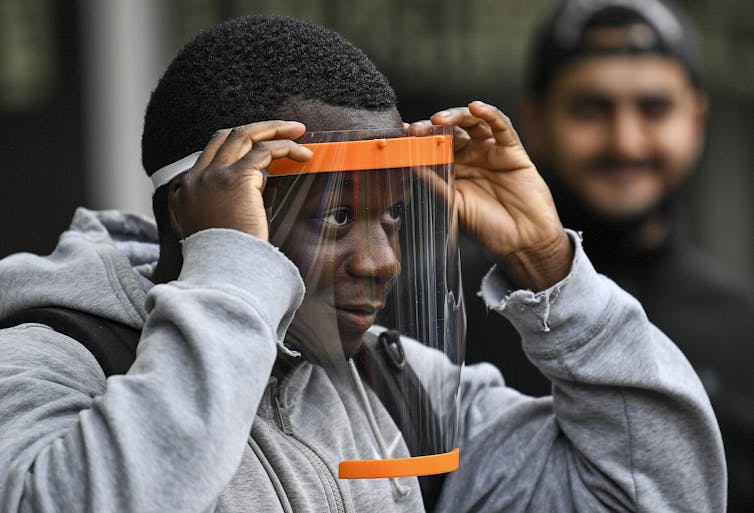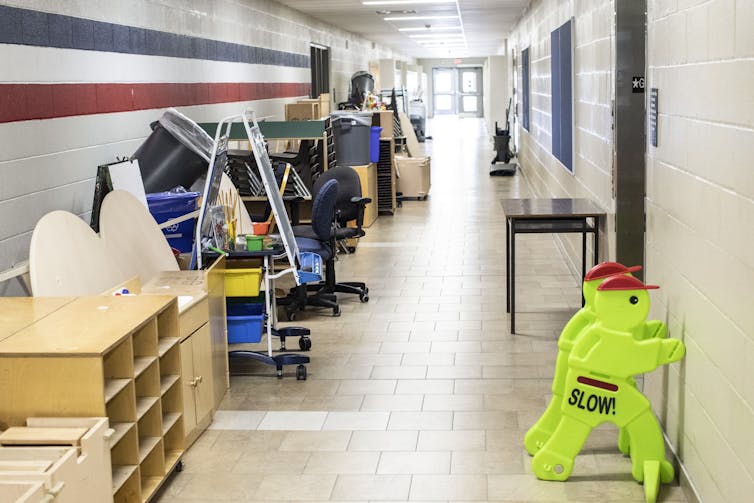As school boards across Ontario announce they’re reopening in September, parents worry about two things: Will my children and I be safe, and will my children learn appropriately?
In Ontario’s large urban centres, some children will not be safe in classrooms in September. Among the returning cohort will be asymptomatic carriers of COVID-19. The science is clear that asymptomatic children have unknowingly spread the virus to others in schools.
School children have also infected their parents.
Otto Helve, a pediatric infectious disease expert, correctly observed: “Outbreaks in schools are inevitable.”
New outbreaks despite safety measures
Experience around the world confirms Helve’s point. More than 20 countries reopened schools this past spring, using a variety of infection control strategies. But virus outbreaks occurred anyway; schools in China, Israel and South Korea had to close again.
In Germany, the proportion of children under age 19 that comprised the cluster of new infections doubled in a two-month period after schools reopened. A few countries never closed schools. Virus outbreaks occurred.

Canada’s experience is similar. A reopened elementary school in Trois-Rivières, Québec, had nine of 11 students infected after one contracted the virus, despite using prevention measures. COVID-19 appeared in British Columbia schools after they reopened in June. Similar outbreaks occurred in daycare centres outside of Toronto and Montréal.
The Ottawa School Board proposed to the province to reopen its 72 schools five days a week in September. Dr. Vera Etches, Ottawa’s medical officer of health, supported the board. She recommended “starting with five days of school in-person and working to make this as safe as possible through reasonable and feasible infection prevention and control measures ….”
Unsafe premise
The error of Dr. Etches’ analysis begins with an unsafe premise — schools must reopen in September.
The first question should be whether schools can implement public health measures by September that will reduce risk of virus outbreaks to acceptable proportions. The answer to that question in many Ontario municipalities is no.
The human, physical and financial resources required to contain the inevitable outbreaks are large, complicated, contested and not in place. Time is necessary to plan, organize and implement. Time ran out months ago.

Ontario’s reopening plan
Ontario announced its plan to reopen schools on July 30.
Elementary and some secondary schools will reopen with in-class instruction five days a week. Secondary students in 24 designated boards — mainly in urban and high enrolment suburban areas — will attend school in cohorts of up to 15, alternating between in-person days and online study.
Ontario will spend $309 million on its plan, mostly for purchasing personal protective and medical equipment, nursing services and for cleaning of schools and buses; $30 million of this is for hiring teachers to support the smaller classes.
The plan’s safety measures are not robust. Most Ontario schools cannot support two-metre distancing. Ontario, accordingly, is requiring only “as much distancing as possible.”
Students to Grade 3 are not required to wear masks. Plexiglass shields will not be installed to deal with the inability to distance students or impose masking requirements on them. There will be no substantial renovations to school buildings to make schools as safe as possible.
Ontario’s plan requires staff and students to self-screen for the virus every day. Schools will not do the testing.
The province took a hard decision in an area fraught with uncertainty. This much, however, is sure. Outbreaks of the virus will occur in the reopened schools. Asymptomatic carriers among the returnees will transmit the virus to their classmates, parents and teachers.
Whether the outbreaks will be contained with isolation and contact tracing, or rage out of control – Florida-like – imperilling whole communities, nobody knows. It’s not inaccurate to consider the plan an experiment.
Reopen in January at the earliest
Ontario should delay reopening schools until January or September 2021. The province should put school boards to work now renovating schools for the best possible safety protocols. Ontario should not experiment with our children.
Ontario should also work with the federal government to develop resources to test each child for the virus every day. Several companies and academic laboratories are developing easy-to-use diagnostic tests that could be used by schools, including a spit-test that looks for traces of SARS-CoV-2, the virus that causes COVID-19. Federal and provincial governments should organize, fund and fast-track getting this, and similar tests, into schools for January or September 2021.
Invest in remote learning now
Ontario boards failed woefully to educate students online from March through June. Since Ontario’s plan contains no new measures to improve the education children will get online, this failure will simply continue in many secondary schools. The plan will also compromise face-to-face education in these schools by deleting 50 per cent of their in-person instruction.
Ontario should invest heavily now in remote education. Remote learning is a relatively new science that arose out of a revolution in educational theory and produced distinctive educational practices. It is interactive, student-centred, digital — altogether different from reproducing existing classroom practices online, as occurred from March through June.
For remote learning, Ontario’s plan invites students to tune into TVO’s Independent Learning Centre and attend its menu of courses. It also instructs teachers to upload materials onto a specialized online platform. This is insufficient.
Specialists are needed to help teachers transform their courses into proper remote formats. These need to be hired, tech resources for universal and equal access must be purchased and people trained how to use them. Educators and staff should be trained in remote learning techniques.
Ontario’s plan does not devote dollars to any of this. It leaves teachers to fend for themselves. It also leaves families adrift, anticipating, for example, that “families with multiple children may need to take turns using the family’s devices or broadband access.”
Teachers, students, families need support
Teachers cannot become experts at remote education on their own. Students need help to adapt to the student-centred practices of remote techniques. And families need support.
Remote teaching, done properly, could allow children to learn appropriately. Good remote teaching, which should be the province’s priority, will not happen by ordering teachers to upload materials or students to watch TVO.
An ecosystem of good remote teaching will be created by training, support, resources and leadership to nudge the cumbersome educational system into a new direction. These pieces are missing from Ontario’s plan.
Remote teaching, even of superior quality, does not replace the social experiences children get in school or the care-giving relief schools provide for working parents.
Children should return to school when the virus is sufficiently under control in their community and their school is made safe. Until then — which will not be this September — Ontario should concentrate on providing leadership and resources to make schools safe and enable superior remote learning.
The investments made now will pay back for years to come as elementary and secondary education is transformed.
We have in front of us a challenge and an opportunity, both of monumental importance. We have tens of thousands of great teachers waiting to rise to the challenge. Ontario should empower them to seize the opportunity.

